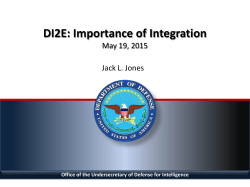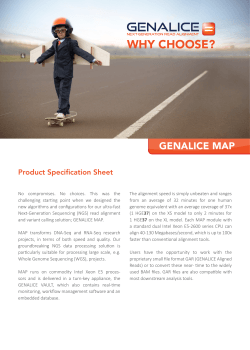
Large-Data Software Defined Visualization on CPUs
Large-Data Software Defined Visualization on CPUs Greg P. Johnson, Bruce Cherniak 2015 Rice Oil & Gas HPC Workshop Trend: Increasing Data Size • Measuring / modeling increasingly complex phenomena • Rendering is typically performed on discrete accelerators Implications • Interactivity harder to achieve • Requires moving data è bandwidth, storage, security issues • Limits usage models (e.g. for in-situ visualization, computational steering) • Limits scalability for visualization • Increased spatial / temporal resolution: more difficult to interpret visually Copyright © 2014, Intel Corporation. All rights reserved. 2 Corollary: Workflow Moving into Data Center… Instruments Simulation Old: Data Center New: Copyright © 2014, Intel Corporation. All rights reserved. File I/O Filtering Geometry Rendering Display Data Center Workstation Workstation 3 Software Defined Visualization The concept of doing visualization / rendering entirely in software on CPUs • Treats visualization as another form of parallel compute • Enables vis on compute resources without requiring special purpose hardware and APIs • Advantages • Access to large memory • No need to move data • Enables different models of rendering • Based on standard open source development tools / programming paradigms • Homogenous system design: general purpose nodes Copyright © 2014, Intel Corporation. All rights reserved. 4 Software Defined Visualization: Our Approach Option 1: Support existing APIs (OpenGL*) • Works with existing applications • No code changes or recompilation required • è OpenSWR software rasterizer Option 2: Enable new functionality and improved performance through a new API Application OpenGL* Renderer OpenGL* OSPRay Renderer OpenSWR OSPRay Xeon1 Xeon1 + Xeon Phi 2 • Good option for new applications • Some effort required to enable existing applications • è OSPRay ray tracing based rendering engine 1 Intel® Xeon® processor, 2 Intel® Xeon Phi™ coprocessor. Copyright © 2014, Intel Corporation. All rights reserved. 5 OpenSWR Software Rasterizer • High performance open source software implementation of OpenGL* • Fully multi-threaded and vectorized for Intel® CPUs • Leverages community development effort (Mesa*) • Drop in replacement for OpenGL* library • Implements an increasing subset of OpenGL* as required by vis applications Copyright © 2014, Intel Corporation. All rights reserved. 6 OpenSWR Performance (Single Node, vs Mesa) 40 Frames Per Second (Higher is Better) Intel® Xeon® E5-2687W v3 Intel Software Rasterizer 1.4 2 x 10 cores, 3.1 GHz 30 Intel® Xeon® E5-2687W v3 Mesa 10.2, Gallium-LLVMPipe 2 x 10 cores, 3.1 GHz 20 ParaView 4.1, Kitware build OpenGL 1.4, Display Lists Image Resolution: 1920 x 1080 10 0 Source: Intel 0.7 2.9 9.9 17.5 24.0 Millions of Triangles 33.4 49.9 Software and workloads used in performance tests may have been optimized for performance only on Intel microprocessors. Performance tests, such as SYSmark and MobileMark, are measured using specific computer systems, components, software, operations and functions. Any change to any of those factors may cause the results to vary. You should consult other information and performance tests to assist you in fully evaluating your contemplated purchases, including the performance of that product when combined with other products. For more information go to http://www.intel.com/performance. Copyright © 2014, Intel Corporation. All rights reserved. 7 OpenSWR Performance (Multi-node) 8 SWR Performance Scaling (ParaView 4.2) 7 6 FPS 5 4 3 2 FIU SWR, 4000 streamlines (47m triangles) 1 RM SWR (316m triangles) 0 1 2 4 Node count 8 16 32 Results measured on TACC Stampede cluster (dual-socket Intel Xeon® E5-2680, 32GB per node, NVIDIA K20 discrete GPUs, 5GB) and based on internal Intel analysis. Software and workloads used in performance tests may have been optimized for performance only on Intel microprocessors. Performance tests, such as SYSmark and MobileMark, are measured using specific computer systems, components, software, operations and functions. Any change to any of those factors may cause the results to vary. You should consult other information and performance tests to assist you in fully evaluating your contemplated purchases, including the performance of that product when combined with other products. For more information go to http://www.intel.com/performance. Copyright © 2014, Intel Corporation. All rights reserved. 8 OpenSWR Software Rasterizer • Open source: Apache 2.0 license • Alpha released in December 2014 • Currently supports OpenGL* 1.4 • OpenGL* 2.x support coming soon • Current users: • TACC, Kitware, University of Tennessee • Download at: http://www.openswr.org Copyright © 2014, Intel Corporation. All rights reserved. 9 OSPRay Ray Tracing Based Rendering Engine • High performance, scalable open source rendering API • Enables expanded functionality • Additional visual cues (shadows, ambient occlusion, etc.) Traditional direct illumination only With ambient occlusion FIU Ground Water Flow data set courtesy of Florida International University and TACC. Copyright © 2014, Intel Corporation. All rights reserved. 10 OSPRay: Additional visual cues example Traditional direct illumination only FIU Ground Water Flow data set courtesy of Florida International University and TACC. Copyright © 2014, Intel Corporation. All rights reserved. 11 OSPRay: Additional visual cues example With ambient occlusion FIU Ground Water Flow data set courtesy of Florida International University and TACC. Copyright © 2014, Intel Corporation. All rights reserved. 12 OSPRay Ray Tracing Based Rendering Engine • High performance, scalable open source rendering API • Enables expanded functionality • Volume rendering Heptane volume (256^3). Data courtesy SCI Institute, University of Utah. Copyright © 2014, Intel Corporation. All rights reserved. Richtmyer-Meshkov volume (2048^3 uint8, 8 GB). Data courtesy TACC. Isotropic Turbulence volume (2048^3 float, 32 GB). Data courtesy TACC. 13 OSPRay Ray Tracing Based Rendering Engine • Provides improved performance • Fully multi-threaded and vectorized for Intel® CPUs and Intel® Xeon Phi™ coprocessors • Data parallel (multi-node) rendering • Integrating into select vis applications • VTK* • ParaView* • VisIt* Copyright © 2014, Intel Corporation. All rights reserved. 14 OSPRay Ray Tracing Based Rendering Engine • Open source: Apache 2.0 license • Alpha released in December 2014 • Current users: TACC, Kitware, University of Tennessee, University of Utah, SURVICE Engineering • Download at: http://www.ospray.org Copyright © 2014, Intel Corporation. All rights reserved. 15 Applications to Oil & Gas Visualization • Large data is a key challenge • Data sets often 100 GB to 1.5 TB in size (and beyond!) • Large data can be more difficult to visually interpret • Existing vis tools often not well optimized • By rendering on CPUs… • We have access to larger memory • Have access to additional rendering techniques • Can use HPC systems for visualization Copyright © 2014, Intel Corporation. All rights reserved. 16 OSPRay Demo Volume Viewer (animation) 25 million triangle “horizons” (rendered “into” volume) Volume rendering Arbitrary slicing (can interactively move even in 100GB volumes) Data: University of Texas at Austin, Bureau of Economic Geology Copyright © 2014, Intel Corporation. All rights reserved. 17 17 Summary: Software Defined Visualization Compute Nodes Visualization Nodes General Purpose Nodes (Compute and Visualization) Cloud or Network New Model Old Model Workstation • OpenSWR (http://www.openswr.org) • OSPRay (http://www.ospray.org) Copyright © 2014, Intel Corporation. All rights reserved. 18 Legal Disclaimer • Roadmap Notice: All products, computer systems, dates and figures specified are preliminary based on current expectations, and are subject to change without notice. • Intel® Advanced Vector Extensions (Intel® AVX/ Intel®AVX2): Intel® AVX/AVX2 is designed to achieve higher throughput in certain integer and floating point operations. Depending on processor power and thermal characteristics, and system power and thermal conditions, AVX/AVX2 floating point instructions may run at lower frequency to maintain reliable operations at all times. For further details see product data sheet. • Software and workloads used in performance tests may have been optimized for performance only on Intel microprocessors. Performance tests, such as SYSmark* and MobileMark*, are measured using specific computer systems, components, software, operations and functions. Any change to any of those factors may cause the results to vary. You should consult other information and performance tests to assist you in fully evaluating your contemplated purchases, including the performance of that product when combined with other products. For more information go to http://www.intel.com/performance. Knights Landing and other code names featured are used internally within Intel to identify products that are in development and not yet publicly announced for release. Customers, licensees and other third parties are not authorized by Intel to use code names in advertising, promotion or marketing of any product or services and any such use of Intel's internal code names is at the sole risk of the user. Intel, the Intel logo, Xeon and Intel Xeon Phi are trademarks of Intel Corporation in the U.S. and/or other countries. *Other names and brands may be claimed as the property of others. © 2015 Intel Corporation Copyright © 2014, Intel Corporation. All rights reserved. 19 Intel's compilers may or may not optimize to the same degree for non-Intel microprocessors for optimizations that are not unique to Intel microprocessors. These optimizations include SSE2, SSE3, and SSE3 instruction sets and other optimizations. Intel does not guarantee the availability, functionality, or effectiveness of any optimization on microprocessors not manufactured by Intel. Microprocessor-dependent optimizations in this product are intended for use with Intel microprocessors. Certain optimizations not specific to Intel microarchitecture are reserved for Intel microprocessors. Please refer to the applicable product User and Reference Guides for more information regarding the specific instruction sets covered by this notice. Notice revision #20110804 Copyright © 2014, Intel Corporation. All rights reserved. 20
© Copyright 2025









